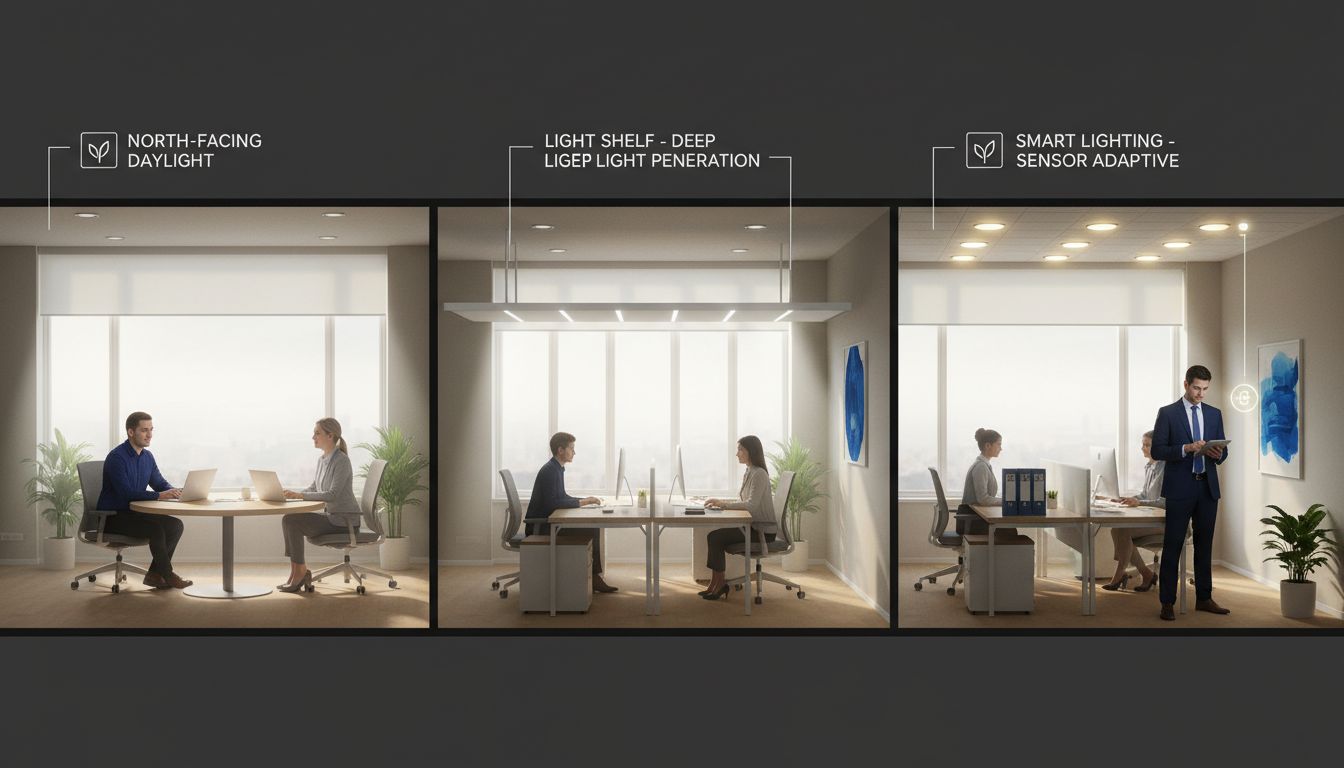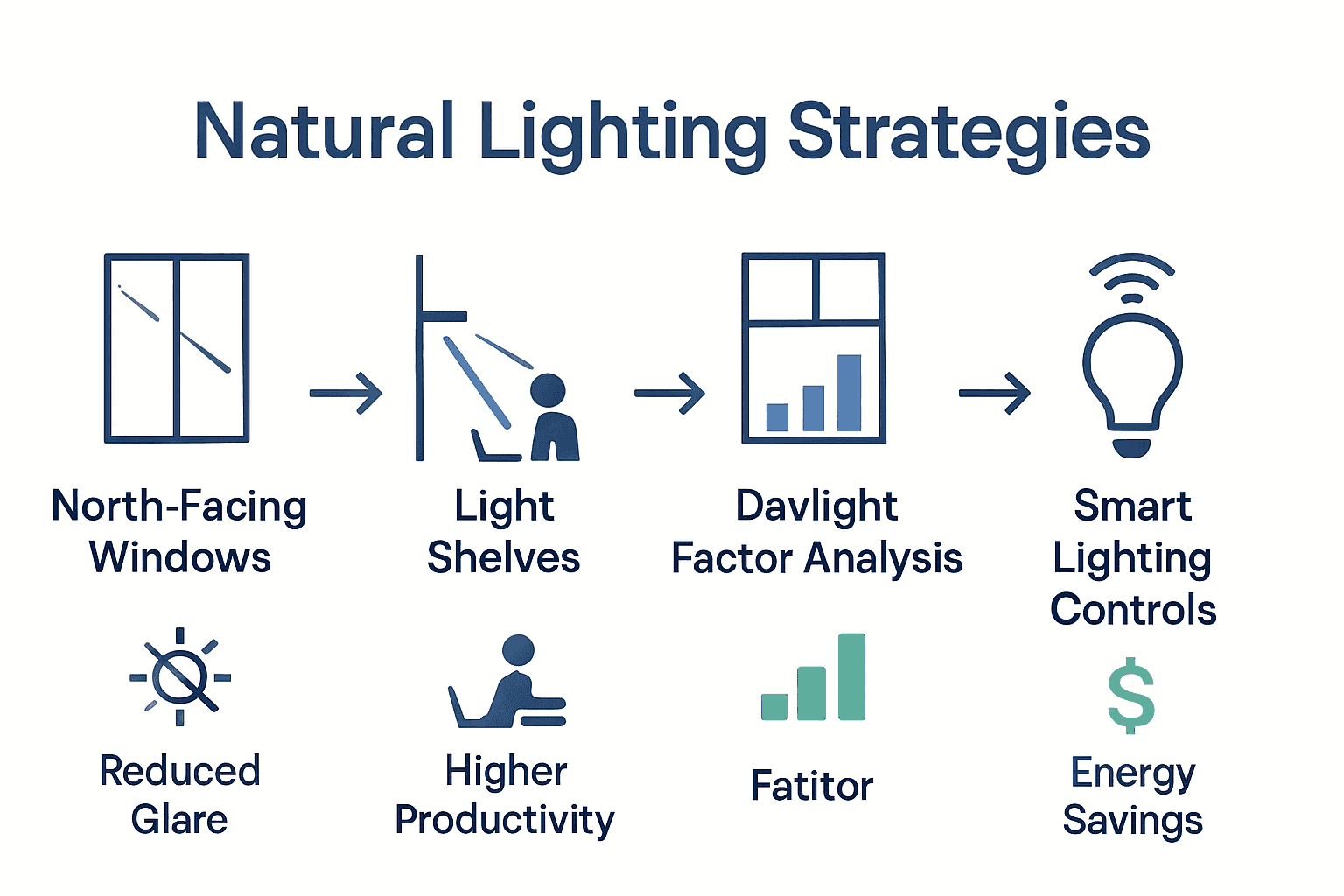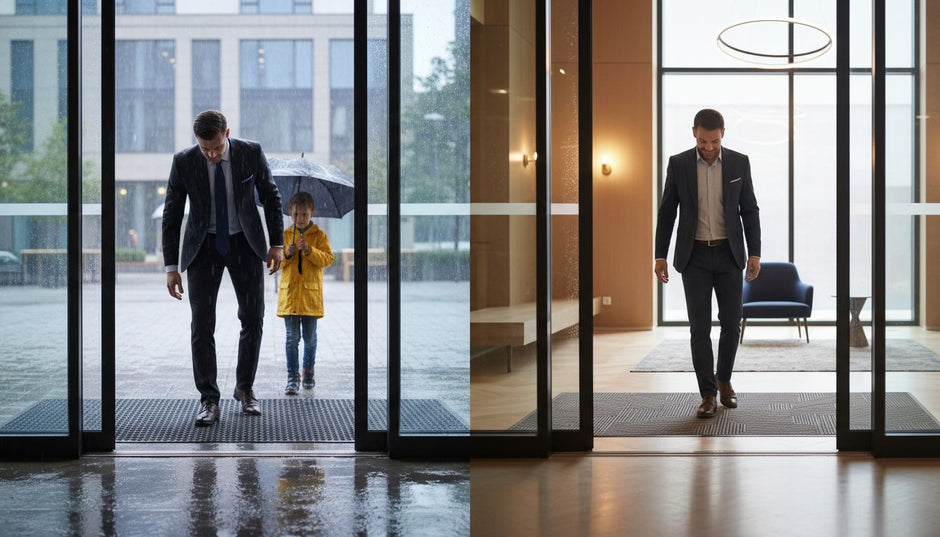Did you know that workplaces filled with natural light see a 15 percent boost in productivity and fewer sick days? Bright, sunlit spaces do more than look good—they shape mood, creativity, and energy each day. Thoughtful use of natural lighting in offices can transform routine environments into places that support well-being and help people do their best work, all while lowering costs and improving satisfaction.
Table of Contents
- Defining Natural Lighting In Work Environments
- Major Health And Productivity Advantages
- Energy Efficiency And Cost Reduction
- Real-World Success Stories In U.S. Facilities
- Best Practices For Maximizing Daylight Indoors
Key Takeaways
| Point | Details |
|---|---|
| Impact of Natural Light | Natural lighting enhances workplace performance and employee well-being, leading to lower stress levels and higher job satisfaction. |
| Energy Efficiency | Implementing natural lighting strategies can significantly reduce operational costs and energy consumption, promoting sustainability. |
| Effective Design Techniques | Employing architectural strategies, such as light shelves and smart lighting controls, maximizes daylight while minimizing glare and energy use. |
| Holistic Approach | Successful integration of natural lighting requires a combination of design, material selection, and an understanding of human light perception to create optimal workspaces. |
Defining Natural Lighting in Work Environments
Natural lighting represents more than just sunlight entering a workspace - it’s a sophisticated architectural strategy that profoundly impacts human performance, well-being, and productivity. Natural light transforms work environments from sterile, artificial spaces into dynamic, energizing settings that support employee health and cognitive function.
According to architectural research, natural lighting can be quantified through specific metrics like the daylight factor. As defined by Wikipedia, the daylight factor is a comprehensive measurement that evaluates natural illumination by considering direct sky light, external surface reflections, and internal surface reflections. This nuanced approach allows designers and facility managers to precisely assess and optimize lighting conditions.
One particularly effective natural lighting technique is north light, a strategic approach utilized in architectural design. Wikipedia describes north light as sunlight entering through north-facing windows, characterized by consistent illumination without harsh shadows. This lighting method provides several key advantages for work environments:
- Stable and uniform light distribution
- Minimal glare and eye strain
- Consistent color temperature throughout the day
- Reduced need for artificial lighting
By understanding these scientific principles of natural lighting, businesses can create work environments that are not just visually appealing, but scientifically optimized for human performance and well-being.
 The goal is transforming spaces from mere functional areas into dynamic, health-supporting ecosystems that naturally enhance employee engagement and productivity.
The goal is transforming spaces from mere functional areas into dynamic, health-supporting ecosystems that naturally enhance employee engagement and productivity.
Major Health and Productivity Advantages
Natural lighting isn’t just an aesthetic choice - it’s a powerful tool for enhancing workplace performance and employee well-being. Scientific research reveals that strategic exposure to natural light can trigger profound physiological and psychological benefits that directly impact organizational success.
According to groundbreaking research from the National Center for Biotechnology Information, workplace environments with increased natural light exposure demonstrate significant mental health advantages. The study revealed compelling evidence that employees working in spaces with greater sunlight experience:
- Lower levels of depression and anxiety
- Higher job satisfaction rates
- Increased organizational commitment
- Improved overall psychological well-being
Beyond mental health, natural lighting delivers tangible productivity improvements. Employees exposed to consistent, high-quality natural light demonstrate enhanced cognitive performance, faster reaction times, and more consistent work output. The physiological mechanisms behind these improvements involve regulating circadian rhythms, stimulating vitamin D production, and supporting optimal hormone balance.
Businesses investing in natural lighting strategies aren’t just creating visually appealing workspaces - they’re engineering human performance. By understanding and implementing sophisticated lighting design, organizations can create environments that naturally boost employee energy, creativity, and engagement. Learn more about optimizing workplace environments in our workplace productivity guide.
Energy Efficiency and Cost Reduction
Natural lighting isn’t just an aesthetic enhancement - it’s a strategic approach to dramatically reducing operational costs and improving energy efficiency in modern workspaces. By leveraging sunlight as a primary illumination source, organizations can unlock substantial financial and environmental benefits.
According to research from the National Renewable Energy Laboratory, daylighting strategies offer remarkable utility cost reductions. The comprehensive report highlights how natural lighting directly decreases the need for artificial illumination, leading to significant energy savings. Key financial advantages include:
- Reduced electricity consumption
- Lower utility expenses
- Decreased maintenance costs for lighting infrastructure
- Minimized carbon footprint
Technological advancements are further amplifying natural lighting’s efficiency potential. Innovative research from arXiv demonstrates cutting-edge lighting control systems that optimize energy usage through intelligent sensor technologies. These systems can dynamically adjust artificial lighting based on natural light availability, ensuring optimal illumination while maximizing energy conservation.
By integrating smart design principles and advanced technologies, businesses can transform their spaces into energy-efficient environments. This approach not only reduces operational costs but also demonstrates a commitment to sustainability and responsible resource management. For a deeper exploration of energy-efficient building strategies, check out our energy efficiency in buildings guide.
Real-World Success Stories in U.S. Facilities
Natural lighting isn’t just a theoretical concept - it’s a transformative strategy that has demonstrably reshaped workplace environments across various U.S. industries. Real-world implementations showcase the profound impact of strategic daylighting on organizational performance and employee experience.
According to Iskalo Development Corp., organizations implementing comprehensive natural lighting strategies have witnessed remarkable outcomes. Their research highlights tangible benefits that extend far beyond aesthetic improvements:
- Better overall employee health
- Increased workplace productivity
- Substantial reductions in utility costs
- Enhanced organizational operational efficiency
Millers at Work further validates these findings, demonstrating how natural lighting profoundly influences multiple dimensions of workplace performance. Their research reveals that strategic daylighting supports critical employee wellness factors, including improved mood, vision health, sleep quality, and cognitive function.
Businesses implementing these insights are essentially redesigning workplace ecosystems to support human potential. By prioritizing natural light, organizations create environments that not only reduce operational costs but also cultivate more engaged, healthy, and productive workforces. For more insights into optimizing workplace environments, explore our facility management best practices guide.
Best Practices for Maximizing Daylight Indoors
Maximizing natural light isn’t just about installing larger windows - it’s a sophisticated design strategy that requires thoughtful architectural planning and innovative techniques. Successful daylighting transforms indoor spaces, creating environments that are both visually appealing and functionally superior.
Architectural design offers powerful solutions for enhancing indoor daylight. Wikipedia introduces the architectural light shelf, an ingenious horizontal surface designed to reflect daylight deep into interior spaces. Strategically positioned above eye level with high-reflectance surfaces, these light shelves provide several critical advantages:
- Maximize daylight penetration
- Reduce direct glare
- Distribute light more evenly
- Enhance overall indoor lighting quality
Understanding human perception of light is equally crucial. The Kruithof curve reveals fascinating insights into how humans perceive illumination comfort. This scientific framework helps designers create indoor environments that balance light intensity and color temperature, ensuring spaces feel naturally comfortable and visually harmonious.
Here’s a comparison of key natural lighting techniques and their workplace benefits:

| Technique | Description | Main Benefits |
|---|---|---|
| North Light | Sunlight from north-facing windows | Uniform light Low glare Stable color temp |
| Architectural Light Shelf | Horizontal surface to reflect daylight | Deep daylight penetration Glare reduction |
| Daylight Factor Analysis | Metric to assess daylight quality | Precise lighting optimization Design accuracy |
| Smart Lighting Controls | Sensor-based light adjustment | Energy savings Consistent illumination |
Successful daylighting requires a holistic approach that combines architectural design, material selection, and scientific understanding of human visual perception. By implementing these sophisticated strategies, organizations can create indoor environments that not only look beautiful but actively support human well-being and productivity. For comprehensive insights into creating optimal workplace environments, explore our facility management best practices guide.
Enhance Your Workspace with Smart Flooring Solutions That Complement Natural Lighting
The article highlights how natural lighting can transform workplaces by improving employee well-being, productivity, and energy efficiency. However, one challenge many businesses face is creating a cohesive environment where every element supports this goal. Floors often get overlooked despite being a major part of any workspace atmosphere. Selecting the right floor mats not only contributes to safety and comfort but also enhances the overall appeal of your naturally lit spaces. Think about anti-fatigue mats that reduce strain while employees benefit from natural light or branded mats that reinforce a welcoming and professional atmosphere.
At Mats4U.com, you can find a wide selection of commercial floor mat options designed to support high-traffic and industrial environments. Our mats are made in the USA for durability and come with features that perfectly complement your daylight-optimized workspaces. Don’t wait to improve both your employees’ comfort and workplace efficiency by pairing those natural lighting benefits with smart flooring solutions. Explore our range today and take advantage of free delivery on orders over $100 to create healthier, more productive work environments now. Start your journey at Mats4U.com and discover how simple floor upgrades can power your naturally bright office.
For more insights on creating productive environments, check our facility management best practices guide and learn how to maximize both lighting and flooring investments.
Frequently Asked Questions
What are the main benefits of natural lighting in work environments?
Natural lighting enhances employee well-being, reduces depression and anxiety, increases job satisfaction, and improves cognitive performance, leading to higher productivity levels.
How does natural lighting contribute to energy efficiency?
Natural lighting reduces the need for artificial lighting, leading to lower electricity consumption, decreased utility expenses, and a smaller carbon footprint, resulting in significant cost savings.
What techniques can be used to maximize natural light indoors?
Techniques such as utilizing north-facing windows, implementing architectural light shelves, and employing smart lighting controls can greatly enhance natural light penetration and quality inside workspaces.
How does natural lighting impact employee health and productivity?
Research shows that exposure to natural light can improve mood, vision health, sleep quality, and cognitive function, ultimately leading to a more engaged and productive workforce.







